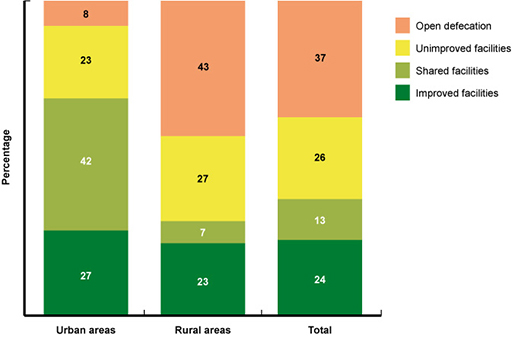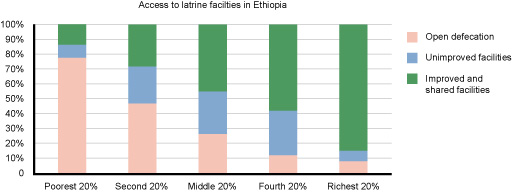3.2.2 Sanitation and sewerage services
Figure 3.3 shows 2012 data on access to different types of sanitation facilities in Ethiopia. It shows that the situation in urban areas is much better than in rural parts of the country. However, 8% of the urban population still practised open defecation at that time. This is an estimated 1.2 million people, equivalent to almost 40% of the population of Addis Ababa or more than four times the population of Gondar or Dire Dawa.

In addition to urban and rural differences, economic status has a significant impact on sanitation access. Figure 3.4 shows the percentage of high and low-income communities in Ethiopia with access to latrines. Of those in the richest communities, only about 8% used open defecation in 2012 and 92% of the community used latrine facilities of some kind. However, in the poorest communities, 78% of the people used open defecation and only 22% used latrine facilities. Although the government of Ethiopia is making an effort to provide services equitably, more work is needed to achieve desired levels of service provision, especially to poorer communities.

Water-flushed toilets need to be connected to a septic tank or to a sewer network. A sewer network includes a system of underground lines (pipes) for collecting and removing liquid wastes from residential, commercial and industrial sources (MoWUD, 2006). The sewerage system is used for two major liquid waste categories: blackwater and greywater.
What is meant by the terms greywater and blackwater?
Greywater is liquid waste from showers, wash basins, dish washing in kitchens and clothes washing. Blackwater is the water flushed from toilets and contains faeces and urine. (You read about this in Study Session 2.)
Most towns and cities in Ethiopia do not currently have a sewer network or sewage treatment system. (Sewage means combined greywater, blackwater and other wastewater. It is not the same as sewerage, which means the network of pipes that carry sewage.) In Addis Ababa some central areas have sewerage services that collect and transfer sewage to the treatment works. Elsewhere people rely on septic tanks and pit latrines. These both need regular emptying to safely remove and dispose of faecal sludge.
The local municipality may provide emptying services using vacuum trucks. These trucks provide collection and transport of faecal sludge from households and institutions on a needs basis. Although published statistics are not available, it is often the case that the available trucks cannot meet the demand and users may have to wait to get the service. The waiting time can vary between weeks and months, depending on the available equipment and manpower. Such vacuum truck services may not only be unavailable but also unaffordable.
3.2.1 Water supply services
